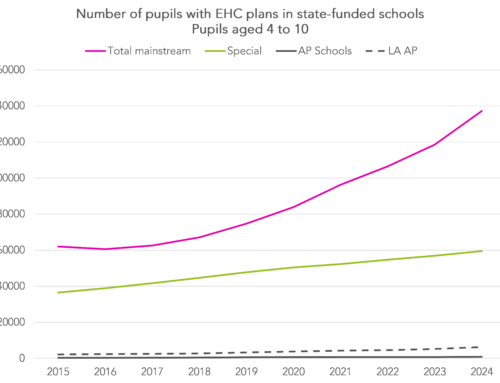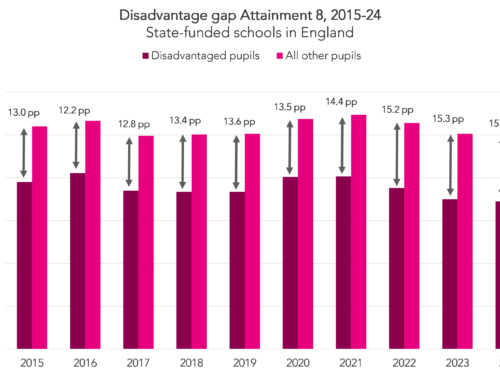In part one we set out how we tried to identify managed moves using data from School Census.
In this part, we examine the characteristics of pupils we think have probably experienced a managed moves and then look at the Key Stage 4 outcomes they achieved.
The characteristics of pupils who experience managed moves
To further dig into the characteristics of pupils who experience a (potential) managed move, we focus on one cohort: pupils aged 11 (Year 7) in 2018/19. These pupils would typically reach the end of Key Stage 4 in 2022/23.
Firstly, we compare the characteristics of pupils we think subsequently experience a managed move between 2018/19 and 2021/22 to the full population in 2018/19.
The managed moves group tends to have lower levels of prior attainment and more likely to have experienced some form of economic, social or educational disadvantage. This includes a higher prevalence of:
- eligibility for free school meals (FSM), including long-term disadvantage[1]
- involvement with social care (either in need or in care)
- identification of special educational needs (SEN), particularly social, emotional and mental health (SEMH) needs
- suspension at primary school, albeit this is still a relatively rare event
Secondly, we compare the managed move group to the group of pupils from the same cohort who experienced permanent exclusion over the same period.
We calculate the measures slightly differently for this comparison, summarizing pupils’ school and social care histories at the point at which they are either excluded or experience a putative managed move.
Here we see that pupils who experience exclusion are even more disadvantaged than those who experience managed moves. This would tend to suggest that pupils who experience exclusions tend to be more complex cases.
This is important for the next stage, in which we compare Key Stage 4 outcomes for those who experience exclusions and managed moves.
The outcomes of pupils who experience managed moves
Firstly, we compare the Key Stage 4 outcomes of pupils who experienced a managed move with the general population.
As would be expected given the level of disadvantage already experienced by the managed move group by the start of secondary school, attainment tends to be low. 27% of such pupils achieved grades 9-4 in GCSE English and maths compared to an average of 64% for the full cohort. These figures include the small proportion of pupils who do we do not observe at any school at the end of Key Stage 4 in 2022/23[2].
Now let’s consider how the outcomes of pupils who experienced a managed move compare to those who experienced permanent exclusion.
As we saw in the previous section, the permanent exclusion group was even more disadvantaged than the managed move group. So for this comparison, we run a statistical (propensity score) matching process which attempts to create matched pairs of pupils. In each pair is one excluded pupil and one pupil who experienced a managed move.
The matching uses a range of variables summarizing pupil school and social care history up to the point at which the exclusion (or managed move) occurred[3].
In Table 5of the annex, we show how well balanced the two groups are on the variables used in the matching process before and after matching. We report the standardized mean difference (SMD) for each variable. After matching all bar one (prior suspensions) are within 0.1 standard deviations.
This comes at a cost, however. We only successfully find 1808 matches out of a total of 3777 potential managed moves.
Nonetheless, we summarise Key Stage 4 attainment for the 1808 matched pairs.
10% of pupils who were permanently excluded are subsequently not observed to have completed Key Stage 4 by the end of 2022/23. This is twice the rate of the managed move group.
Even if we remove those pupils from our calculations, the group of pupils who experience managed moves tend to achieve better, if still somewhat low, outcomes compared to excluded pupils.
The fact that the majority of pupils who we think experience a managed move remain in the mainstream sector is likely to be a factor. This may be less appropriate for those who experience permanent exclusions if the events that lead to their exclusion are of a more serious nature to the events that lead to managed moves.
Summing up
We have attempted to use School Census to identify managed moves. We think that this method is promising but could still be improved further, particularly for the primary years.
That caveat notwithstanding, it seems that as many pupils in the cohort that entered secondary school in September 2018 subsequently experienced a managed move as were permanently excluded.
Pupils who experienced managed moves tend to have experienced multiple forms of disadvantage, however less so than pupils who experienced exclusion.
Where we can find like-for-like matches between the two groups of pupils, we tend to find that those who experience managed moves tend to be higher attaining.
This is not to say that managed moves are appropriate in place of exclusion. Perhaps the cases we have studied here have not reached the bar where exclusion is appropriate. We have also not considered safeguarding risks arising from managed moves.
- Being eligible for FSM in at least 80% of terms from Reception to Year 7
- We assume that these pupils do not achieve any qualifications, hence the figures we present are a “worst case scenario”.
- Key stage 2 mean fine grade in reading and maths, month of birth, gender, ethnicity, % terms eligible for FSM, ever suspended at primary school, SEN provision, ever SEN, number of prior suspensions from Year 7 upwards, ever in need at primary, ever looked after at primary, ever in need at secondary, ever looked after at secondary, ever SEMH, year of exclusion/ managed move, school % disadvantaged, school % known to social care, school mean KS2 result, region. Pupils are matched exactly on gender, year of exclusion/ managed move, number of prior suspensions from Year 7 upwards, ever SEMH, ever in need at primary and ever looked after at primary.
Want to stay up-to-date with the latest research from FFT Education Datalab? Sign up to Datalab’s mailing list to get notifications about new blogposts, or to receive the team’s half-termly newsletter.













Leave A Comment